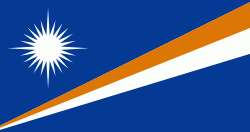Rongerik Atoll (Rongrik Atoll)
Rongerik Atoll or Rongdrik Atoll (Marshallese: Ron̄dik, ) is a coral atoll of 17 islands in the Pacific Ocean, and is located in the Ralik Chain of the Marshall Islands, approximately 200 km east of Bikini Atoll. Its total land area is only 1.68 km2, but it encloses a lagoon of 144 km2.
Rongerik Atoll was claimed by the German Empire along with the rest of the Marshall Islands in 1884. After World War I, the island came under the South Seas Mandate of the Empire of Japan, although the island was uninhabited. The island became part of the vast US Naval Base Marshall Islands. Following the end of World War II, it came under the control of the United States as part of the Trust Territory of the Pacific Islands until the independence of the Marshall Islands in 1986.
It is most famous as the temporary location from March 7, 1946, through March 14, 1948, of the Bikini Atoll's indigenous population while the United States government conducted the Operation Crossroads nuclear tests. After months of food shortages and malnutrition, they were moved first to Kwajalein and finally to Kili Island. On March 1, 1954, Rongerik was exposed to radioactive fallout as a result of the detonation of Operation Castle's Bravo.
According to Spanish researcher Emilio Pastor in a paper submitted to his government in 1948, a number of small islands in Micronesia (Kapingamarangi or Pescadores, Mapia or Güedes, Kiritimati or Matador, Rongerik or Coroa and others) continue legally under Spanish sovereignty. This is because the text of the German–Spanish Treaty of 1899 which transferred sovereignty of certain Spanish possessions in the Pacific to Germany, namely the Northern Mariana Islands (except Guam) and the Caroline Islands (including Palau), failed to include these smaller islands. Although the Spanish government studied the case in 1949 and accepted this interpretation, it has not asserted its claim to the islands.
Rongerik Atoll was claimed by the German Empire along with the rest of the Marshall Islands in 1884. After World War I, the island came under the South Seas Mandate of the Empire of Japan, although the island was uninhabited. The island became part of the vast US Naval Base Marshall Islands. Following the end of World War II, it came under the control of the United States as part of the Trust Territory of the Pacific Islands until the independence of the Marshall Islands in 1986.
It is most famous as the temporary location from March 7, 1946, through March 14, 1948, of the Bikini Atoll's indigenous population while the United States government conducted the Operation Crossroads nuclear tests. After months of food shortages and malnutrition, they were moved first to Kwajalein and finally to Kili Island. On March 1, 1954, Rongerik was exposed to radioactive fallout as a result of the detonation of Operation Castle's Bravo.
According to Spanish researcher Emilio Pastor in a paper submitted to his government in 1948, a number of small islands in Micronesia (Kapingamarangi or Pescadores, Mapia or Güedes, Kiritimati or Matador, Rongerik or Coroa and others) continue legally under Spanish sovereignty. This is because the text of the German–Spanish Treaty of 1899 which transferred sovereignty of certain Spanish possessions in the Pacific to Germany, namely the Northern Mariana Islands (except Guam) and the Caroline Islands (including Palau), failed to include these smaller islands. Although the Spanish government studied the case in 1949 and accepted this interpretation, it has not asserted its claim to the islands.
Map - Rongerik Atoll (Rongrik Atoll)
Map
Country - Marshall_Islands
 |
 |
| Flag of the Marshall Islands | |
The country's population of 42,050 people (at the 2021 World Bank Census ) is spread out over five islands and 29 coral atolls, comprising 1,156 individual islands and islets. The capital and largest city is Majuro. It has the largest portion of its territory composed of water of any sovereign state, at 97.87%. The islands share maritime boundaries with Wake Island to the north, Kiribati to the southeast, Nauru to the south, and the Federated States of Micronesia to the west. About 52.3% of Marshall Islanders (27,797 at the 2011 Census) live on Majuro. In 2016, 73.3% of the population were defined as being "urban". The UN also indicates a population density of 295 PD/km2, and its projected 2020 population is 59,190.
Currency / Language
| ISO | Currency | Symbol | Significant figures |
|---|---|---|---|
| USD | United States dollar | $ | 2 |
| ISO | Language |
|---|---|
| EN | English language |
| MH | Marshallese language |















